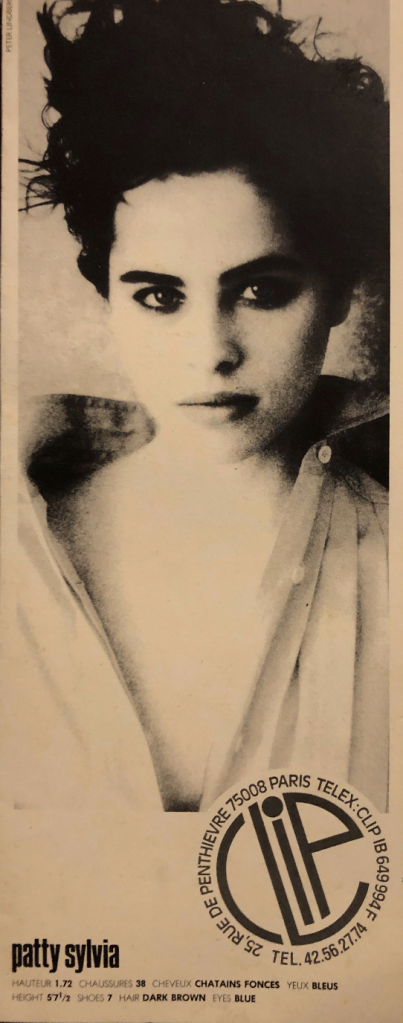She had been trying to figure out what to do for three years after graduating high school, and had stumbled upon modeling. The photographer of the first modeling job she booked in Boston, MA brought her photograph back to their agency in London and they were interested in meeting her.
The London agent liked her and contacted another agency in Paris called Clip where an agent named John Michel took her under his wing. From there, things moved fast. Sylvia moved into a model apartment in Paris. Knowing no French and absolutely nothing about France, she was given a “plan de Paris” (a map) and a list of addresses for photoshoots and fittings. As glamorous and movie-like as this sounds, Sylvia said she has never been so lonely.

“I didn’t know the language, I didn’t know the money, I was totally culture shocked,” said Syvlia. And she had a distaste for Paris as well. “I hated it. There was this vulgarity, I felt very unsafe as a young woman.”
Despite her disdain, Paris loved her; it’s where her modeling career took off. It became her home base, though she traveled all over the world chasing jobs and lived in Tokyo, New York, and Boston for short periods of time.
Once Sylvia’s career had picked up speed, she was taking home $1,250 a day on the days that she worked. Sylvia worked strategically. She did magazine covers for recognition rather than money, recognition in turn helped her land jobs in advertising campaigns, which made her money.
Sylvia was able to be successful in a career where salary varies greatly depending on recognition. Models live an unpredictable lifestyle that lacks stability; they are in a constant state of looking for work and are often traveling. Modeling is an industry that is only accessible to a very select group of people who align with a certain physical criteria, something that can only happen by accident.
Even the inarguably beautiful Sylvia who found success in the industry struggled with the criteria.
“I was never successful in America because my look was too ethnic at the time. I had curly hair and full lips and back then the American ideal of beauty was Cindy Crawford,” she said.
For ten years, Syvia made a career for herself abroad, sometimes happy, and often lonely, until she couldn’t do it anymore.
“I remember my last photoshoot. It was like my body just couldn’t do it anymore. I couldn’t get dressed, I couldn’t put on the makeup, I was just done,” Sylvia said.
As she matured, Sylvia grew tired of not having a say in what she did for a living.
“It got really hard to not have a voice in an industry where you’re an object,” she said. “It’s like you’re a child. You show up for work, you do as you’re told, you’re not a part of anything, there are no choices involved in your day.”


She quit modeling and moved back home to Rhode Island at 30 years old. Though it was all she had known, Sylvia wanted nothing to do with the modeling industry in whatever she did next. She got her bachelor’s degree in psychology, accumulating credits from four different institutions, ultimately graduating from Rhode Island College where she also later earned her master’s in social work.
While in school, Sylvia thought she wanted to work with children and families. Her first two jobs during and after school were working with pregnant and parenting teens who were earning their GED and then counseling women at a shelter for abused women and their children.
Shortly after earning her master’s, Sylvia had her own child, and had to learn to navigate the workplace as a new mom. She felt like no one had prepared her for how jarring that would be.
“I think it’s a disservice not to have those conversations with young women. It’s important because it’s really hard to have a career and be a mom,” she said.
Ultimately, her need to be flexible around her son’s schedule is what led Sylvia to her current area of work as a per diem medical social worker where she primarily works with the elderly.
“I have a real appreciation for old people. When I started working with them, I thought, here’s this population that I adore!” said Sylvia.
Sylvia is a social worker on a hospice team. She sees patients with terminal diagnoses to help make them, as well as their family members, comfortable in their final stage of life. The hospice team, who is overseen by a hospice physician, consists of a nurse, a chaplin (someone who holds a master’s degree in divinity), a social worker, and a certified nurse assistant. Together, the team aims to support the dying patient and their family physically, emotionally, spiritually, and psychologically.
For Sylvia’s role as a social worker specifically, she does initial visits and revisits with patients and their caretakers. During the initial visit, she gathers as much information as she can about the patient and their family. She learns about the patient and family’s familial situation, finances, mental health, and previous experiences with grief. Sylvia helps the family devise a plan for how they will provide 24-hour care for the patient.
She educates the family on what hospice is and what it will offer. She is also there to help caretakers come to terms with letting their loved ones die and informing them what that process will look like.
During revisits, Sylvia checks in on the patient and addresses anything the patient and family might need.
Although Sylvia’s two careers appear vastly different, she feels there is some overlap.
“Modeling prepared me to be able to walk into a room not knowing anyone and feel comfortable in that social setting,” she said.
This is a skill she uses regularly when meeting families for the first time in her current position. Hospice work is admittedly more morbid than modeling, but Sylvia doesn’t seem to be bothered by it. She is fulfilled by her work in a way that she never was with modeling.
“With hospice my focus is how to live until you die. There’s no baloney. You’re meeting people at a vulnerable time in their lives. It’s intimate. It’s real.”
I love this article! I find it so engaging and interesting. You picked a really good person to write the article on, and you did a really good job at mixing information and her actual emotions. The quotes are well done, and I just felt really invested reading it. Good job!
LikeLike